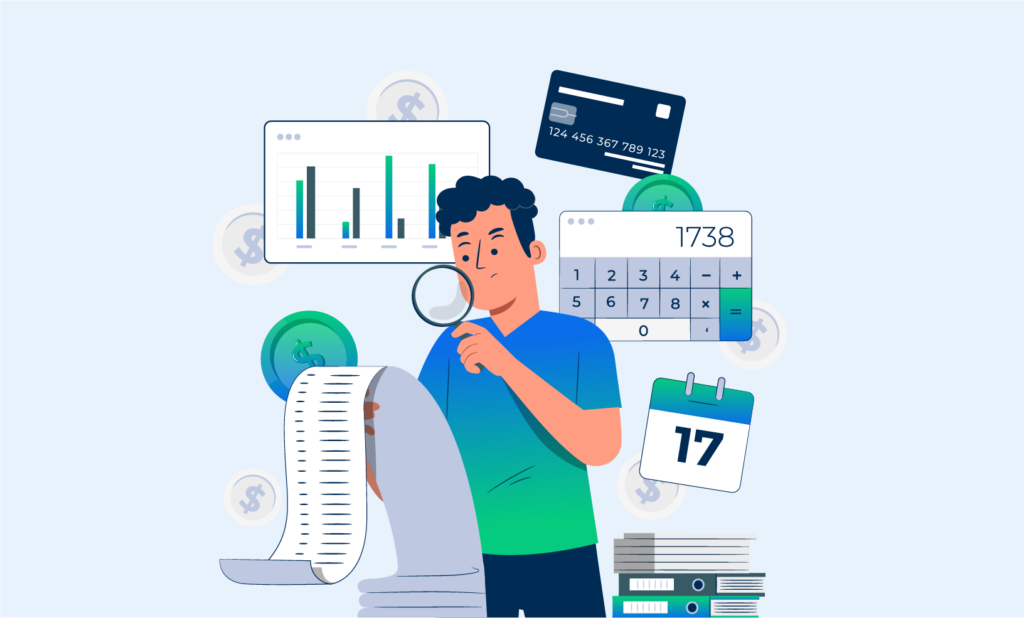How many invoices does your finance team manage?
Keeping track of invoices and payments is one of the most essential tasks for maintaining financial stability. According to the 2019 Automation Trends Survey conducted by Webexpenses and the Association of Certified Accounts Payable Professionals (ACAPP), 48% of businesses handle around 500 invoices each month. Sounds like a lot?
And with the increasing number of clients and transactions, it can quickly become overwhelming and time-consuming. That’s why having an efficient system in place is important for streamlining the process and avoiding any financial discrepancies. In this guide, we will discuss how to keep track of invoices and payments effectively. From creating an invoice tracking system to using software tools, we will cover everything you need to know to keep your invoices in order.

What Does It Mean To Track Invoices?
Simply put, tracking invoices is the process of monitoring and managing all the invoices issued by a company or received from vendors. It involves keeping a record of all transactions, including invoice numbers, dates, amounts, and payment statuses. Tracking invoices ensures that they are paid on time and helps identify any potential issues or discrepancies that may arise.
Here is why it’s important to monitor invoices and payments:
- Financial accuracy: By diligently recording invoice and payment details, businesses can maintain precise financial records. This accuracy is crucial for spotting unrecorded payments or discrepancies swiftly.
- Prompt payment practices: Keeping a close eye on invoices aids in tracking payment deadlines, facilitating timely follow-ups with clients. This contributes to better cash flow and overall business continuity.
- Trend analysis: Examining invoice and payment records can reveal important financial patterns, such as high-demand periods or clients with frequent late payments, guiding smarter financial planning.
- Liquidity oversight: Monitoring the flow of invoices and their settlement is essential for managing a company’s liquidity, ensuring there are adequate funds for operational expenses.
- Reliable financial reporting: Accurate tracking supports the generation of exact financial statements, crucial for strategic decision-making and stakeholder confidence.
- Fraud mitigation: Promptly identifying irregularities in invoices and payments can be a key defense against fraud, safeguarding a company’s financial integrity.
- Reputation management: Ensuring payments are made punctually can help maintain positive relationships with suppliers, avoiding late fees and preserving the company’s market reputation.
As companies grow, they face a more complex financial environment due to an increase in transaction volume, highlighting the need for an effective invoice tracking system. This system helps prevent delayed payments, cash flow issues, and potential fraud. Finance teams, who are directly impacted by the added complexity, may find themselves overburdened, dedicating too much time to managing invoices and resolving discrepancies rather than focusing on strategic financial management and analysis.

How To Keep Track Of Invoices And Payments
Now that we understand why it’s important to track invoices and payments effectively, let’s discuss some practical steps to help you get started.
Step 1: Establish a Standardized Invoice Tracking System
A standardized system is the bedrock of effective invoice management. Ensure it includes:
- Invoice numbering: Implement a system to assign unique numbers to each invoice for easy tracking and reference. This simplification aids in managing financial documents and streamlining audits.
- Terms of payment: Clearly state payment deadlines to avoid misunderstandings and encourage punctuality. This clarity helps mitigate the risk of delayed payments and associated complications.
- Filing system: Create a systematic approach to storing invoices, whether in digital form or physical copies. Such a system should facilitate swift access and retrieval, essential during financial audits or when addressing inquiries.
- Consistent recording procedures: Develop a standardized process for recording key invoice details. Consistency in this area ensures the reliability of your financial data and supports accurate financial analysis and reporting.
Step 2: Use AP Automation Software
Accounts payable (AP) automation software significantly enhances the efficiency of invoice tracking:
- Invoice processing: Automate the tedious tasks of data entry and invoice management to save time and minimize the risk of human error.
- Payment scheduling: Set up automated payments for recurring invoices, reducing the need for manual processing and ensuring timely payments.
- Tracking features: Utilize the software’s tracking capabilities for real-time updates on invoice and payment statuses, providing complete visibility into your accounts payable.
- Data analytics: Leverage the analytical tools included in AP automation software to identify financial trends, pinpoint late payment patterns, and detect discrepancies, enabling informed financial decision-making.
Step 3: Regularly Review and Reconcile Invoices
Diligently reviewing and reconciling invoices against payments and bank statements is essential to:
- Ensure accuracy: This practice verifies that all transactions are correctly recorded, reducing the likelihood of fraud or oversight.
- Identify discrepancies early: Regular audits help detect any issues promptly, allowing for quick resolution and maintaining the integrity of your financial records.
Step 4: Train Employees on Invoice Management Best Practices
Involving your team in the financial management process is key:
- Collaboration is crucial: Educate employees on the importance of efficient invoice management, emphasizing the role of accurate recording and timely follow-up in the company’s financial well-being.
- Best practices: Offer training on the use of your AP automation software, invoice filing system, and the procedures for addressing discrepancies, ensuring everyone is equipped to contribute to the financial efficiency of the business.
Step 5: Keep Communication Lines With Suppliers Open
Maintaining open communication with your suppliers and clients ensures a smooth invoicing process:
- Transparent conversations: Set clear expectations regarding payment terms before entering into agreements to prevent future misunderstandings or disputes.
- Prompt dispute resolution: Being readily available to resolve any issues or discrepancies not only fosters trust but also helps maintain positive, long-term relationships.
- Feedback loop: Encourage and act on feedback regarding your invoicing process. This can provide valuable insights into potential improvements, enhancing efficiency and satisfaction for all parties involved.
In conlusion, a well-designed, standardized system combined with AP automation software can help streamline processes, mitigate fraud, and improve supplier relationships. Regular reviews, employee training, and open communication contribute to the long-term effectiveness of your invoice management strategy. By proactively implementing these steps, you can reduce the time and effort spent on invoice tracking, allowing you to focus your resources on strategic financial decision-making and ultimately preserve your company’s market reputation.

How DOKKA Can Help You Keep Track Of Your Invoices
DOKKA offers an innovative solution tailored to streamline the processes of invoice tracking and management. The journey toward efficient invoice management begins with the capture of invoice data. DOKKA simplifies this process through its advanced technology, enabling the automatic capture of invoice details from various formats. Whether it’s a paper document, PDF, or digital file, DOKKA’s intelligent system extracts crucial information, eliminating the need for manual data entry.
Once invoices are captured, DOKKA’s platform takes automation a step further by processing these documents in real time. Its sophisticated algorithms classify, sort, and file invoices, making them easily accessible for review and approval. DOKKA recognizes the importance of collaboration within financial teams and between businesses and their suppliers. The platform is designed to facilitate seamless communication through its integrated messaging system, enabling team members to discuss and resolve issues directly within the invoice document. Furthermore, DOKKA allows for customizable approval workflows, ensuring that invoices undergo the necessary checks and approvals before payment. With DOKKA, finance teams can easily monitor due dates, track payments, and manage cash flow more effectively. This real-time visibility aids in making informed financial decisions, preventing late payments, and optimizing working capital.
Compatibility with existing accounting systems is a key consideration for any financial management tool. DOKKA seamlessly integrates with a wide range of accounting software, ensuring that the transition to automated invoice management is smooth and frictionless. Last but not least, DOKKA is committed to the highest standards of data security, employing robust encryption and security protocols to protect sensitive information. Moreover, the platform is designed to comply with global financial regulations, ensuring that your business adheres to legal requirements and best practices in financial management.








